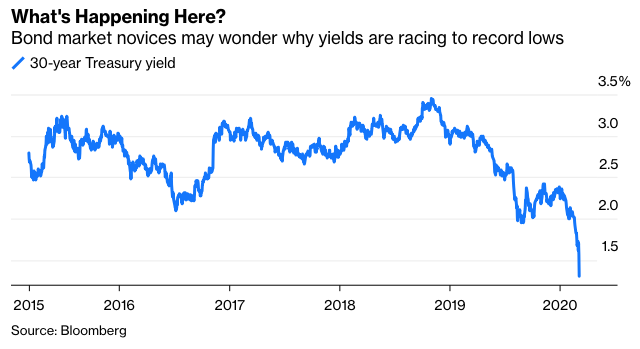After spending almost a decade writing exclusively about bonds, it’s sometimes easy to forget just how counterintuitive they can seem to many casual market observers. One survey last year showed just 8% of Americans could accurately define fixed-income investments, while about half of them answered “I do not understand it at all” with regards to U.S. Treasuries, municipal debt and high-yield corporate securities.
Understandably, those same people might now be confused about what to make of the historic levels reached in the $16.7 trillion Treasuries market over the past two weeks as the coronavirus outbreak intensified. The benchmark 10-year yield dropped below 1% for the first time in 150 years. The Federal Reserve shocked and awed by reducing its key short-term lending rate by 50 basis points in its first emergency interest-rate cut since 2008. Now 30-year Treasuries yield a paltry 1.3%, which is less than the S&P 500’s dividend yield. That had previously never happened since the U.S. government began selling long bonds in the 1970s.

The easiest way to think about these moves is twofold, both from what I’d consider a Main Street perspective. First, it’s cheaper than ever to borrow or refinance if you have strong credit. Rates for 30-year U.S. mortgages have tumbled to 3.29%, down from 3.45% last week and the lowest ever in almost five centuries of data, according to Freddie Mac. Second, individuals should expect to earn less interest going forward from their savings accounts, even the “high-yielding” ones.
But there’s another way to look at the events of the past few weeks, as well as the previous 16 months, through more of a Wall Street lens. While fixed-income investors tend to rightly focus on interest payments, it’s worth remembering that bonds produce total returns just like stocks and other asset classes. And the results have been nothing short of remarkable.
Since early November 2018, when the 30-year Treasury yield peaked at 3.4647%, long bonds have returned 52%, according to ICE Bank of America Corp. index data through March 5. That’s better than almost 90% of the S&P 500 Index. The gain exceeds the overall equity index, which is up just 18%, as well as other safe haven assets like gold (up 32%). Unless you went all-in on Tesla Inc., which has soared more than 100%, you would have been hard-pressed to find a higher-flying investment than the longest-dated Treasuries.
Rapid price appreciation, of course, is not what Treasuries are known for. Despite the huge swings in recent days, bonds on a whole tend to be less volatile than equities.
That means on a risk-adjusted basis, 30-year Treasuries look even better. So much so, in fact, that no company in the S&P 500 Index has fared better since November 2018. That’s right, when taking both total return and volatility into account, long bonds have bested all 500 of the S&P 500 companies (and Tesla, too).
Here’s a chart of the few companies that come close to 30-year Treasuries in risk-adjusted returns:









